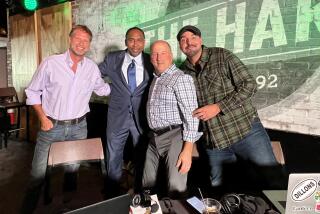CATCH A WAVE: Is the City of...
- Share via
CATCH A WAVE: Is the City of Broad Shoulders--home of sizzling Polish sausages, the brawlin’ Black Hawks and federally subsidized street gangs--ready for New Age Radio? In fact, you can spin your dial here and find (count ‘em) two New Age-style stations. Ironically, the first one, WNUA-FM, which hit the air in August, replaced a classic-rock station that had originally been WMET-FM (sister station of L.A.’s KMET, which was replaced by the Wave). The other new entry is WTWV-FM, which just switched over last month from WZRC-FM (Z-Rock), a popular heavy-metal station. It’s too early to get a ratings fix on WTWV, but WNUA has opened with a batch of strong numbers. In the recent Birch ratings survey, WNUA more than doubled its previous ratings, ranking as high as sixth in the market with its key 25-54 male audience.
“Chicago is a great radio market and really wide open for a new radio station,” said WNUA program director Bob O’Connor. “We were concerned with Chicago audiences being a tough sell for a station with a mellow image, so we’ve positioned ourselves as a more upbeat, foreground type of station. We figure if people embrace us here, then this format could work anywhere .”
After extensive testing here, the station’s parent company, Boston-based Pyramid Broadcasting, opted for what you might call an Urban Contemporary New Age format. Though WNUA relies on the familiar Wave formula of New Age, Diet Pop and Cool Jazz, it’s added a fresh wrinkle, playing regular doses of soft-black artists like Luther Vandross and Peabo Bryson.
“Most of the New Age stations have totally ignored black listeners,” O’Connor explained. “Our research reminded us that this city has a tremendous ethnic mix and that we could really expand our audience by programming to black as well as white listeners. In that sense, we’re really like a second-generation New Age station--we’ve tried to fine-tune the formula.”
Unlike L.A.’s Wave, WNUA offers live deejays, which O’Connor says has helped strengthen the station’s local identity: “We thought having no deejays was taking it too far. What we have is no annoying deejays.” The station also responds to local feedback. Initially, the deejays rarely announced what songs had been played. After the station received 3,000 calls in three weeks, that policy changed. “Now we do a lot of back-announcing,” O’Connor said.
More to Read
The biggest entertainment stories
Get our big stories about Hollywood, film, television, music, arts, culture and more right in your inbox as soon as they publish.
You may occasionally receive promotional content from the Los Angeles Times.









